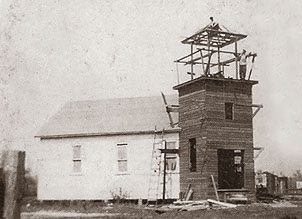|
The History of Lutz - Page 8 |
|
Read the left and right panes before scrolling down to the next levels. Click links to view related photos, use your back browser button to come back to this page. |
|
Click on links in text, they lead to more pictures |
|
|
||
|
During these early times, North Tampa residents got their mail from the Stemper post office, about 3 miles to the south. Early in 1912, they petitioned the U.S. government for their own post office (application made by Guy Sparlin) but they were turned down. They then enlisted the help of George Sibthorpe, the Stemper postmaster. Instead of asking again for another post office, North Tampa residents signed a petition to have the Stemper P.O. moved to North Tampa. Sibthorpe forwarded the petition to the federal officials. |
On January 27, 1913, the U.S. Post Office notified Sibthorpe that the petition had been granted. However, fearing that the North Tampa P.O would be confused with the Tampa P.O, the department insisted that the P.O. be named Lutz, the name taken from the Lutz Junction train depot.
From that day onward, the town became known as Lutz. |
|
|
George Sibthorpe continued as postmaster, working from a 7-foot square building on a lot south of the depot. It was built in one day by C. E. Thomas and the post office in Stemper was shut down. Soon afterward, Sibthorpe moved the P.O. operation into his two-story business building, and later into the train depot.
George Sibthorpe stands in the doorway of the first Lutz post office, which wasn't much bigger than a postage stamp. |
In those days there were no paved roads in Lutz or leading to Lutz. Local roads were sandy and deeply rutted. Travel was so difficult that pioneers often chose to walk on the crossties of the railroad. A dirt road emerged alongside the Tampa Northern Railway shortly after it was built in 1907. The dirt road headed north out of Tampa along the tracks at Nebraska Avenue, then at the present day I-275 overpass, it turned east and curved north on what is now Hanna Road, then back towards present day US 41. Just south of the Lutz Junction, it veered around the east side of the swamps, and entered town through the woods from the east.
In early 1913, a sandy road also led from the Lutz depot to the west, which eventually became 1st Avenue S.W. |
|
|
Early in 1914, the Tampa and Gulf Coast Railroad (the old "Peavine") moved out. In the summer of 1914, residents were so tired of the winding road that led to Lutz from the south and east that men came with their wagons, grub hoes, axes and shovels to fill in the swampy area just south of the depot and north of the original Lutz school. The crossties from the abandoned "old Peavine" were pulled up and used to build the foundation for a road bed through the muck pond. Then they were covered over with dirt and leveled off. The result was a straighter and shorter road into Lutz, by about 1/2 mile. The "old Peavine" tram bed became a sandy trail named Vernon Road, after H. T. Vernon whose property was alongside it. |
In 1914 the United Brethren Church in Christ built their first sanctuary on land donated by C. E. Thomas. A bell tower was later added in 1919, construction shown below.
|
|
|
|
||
